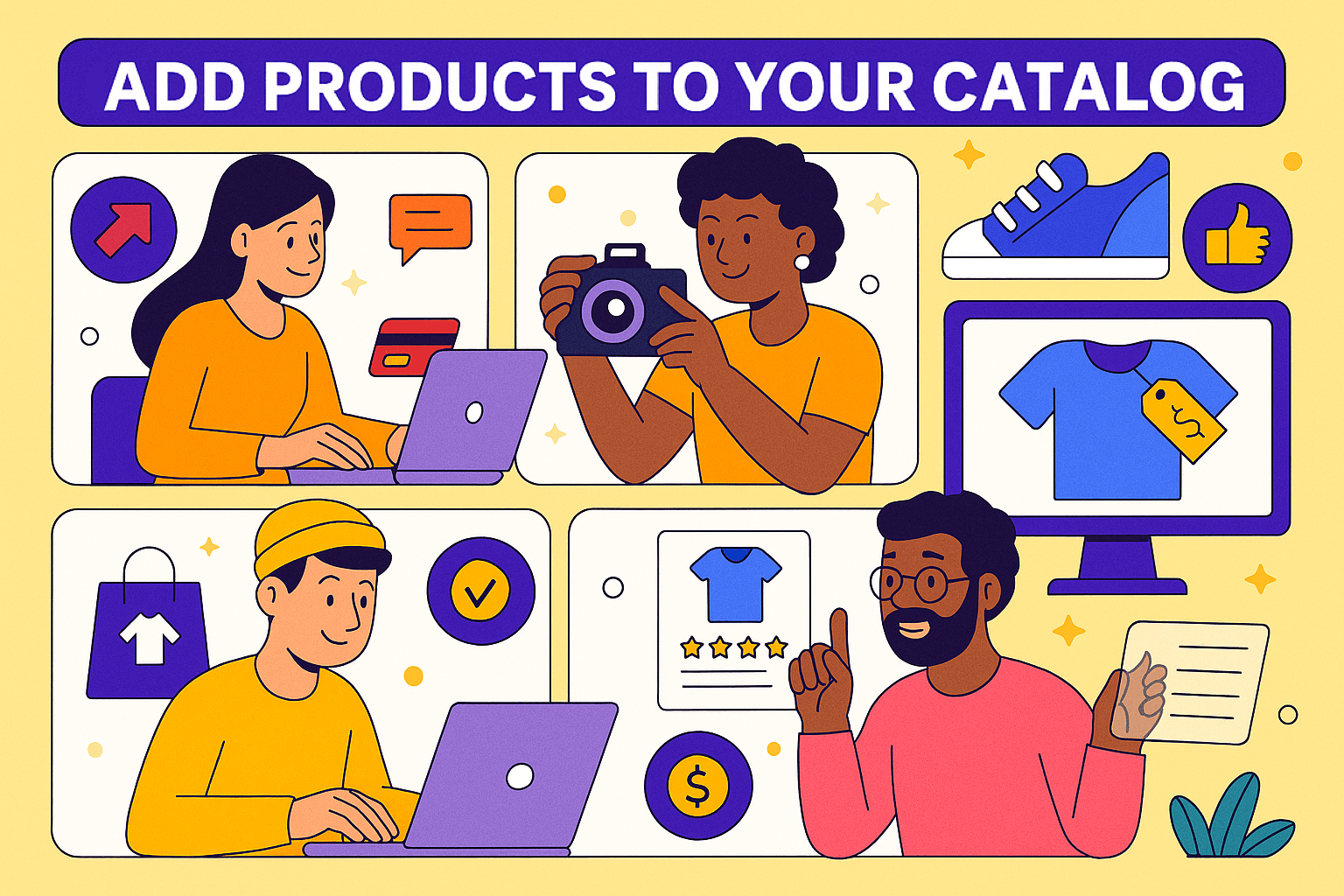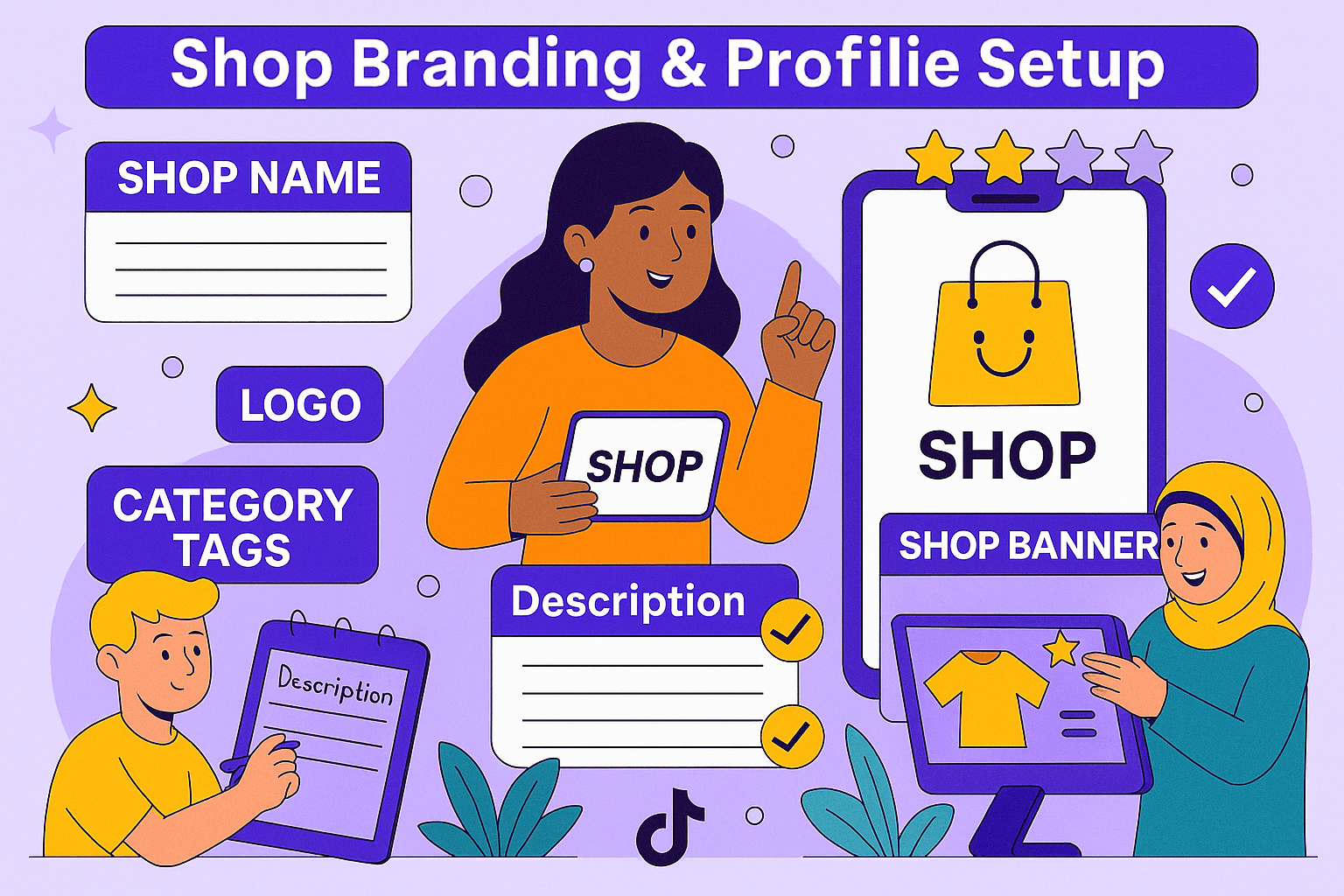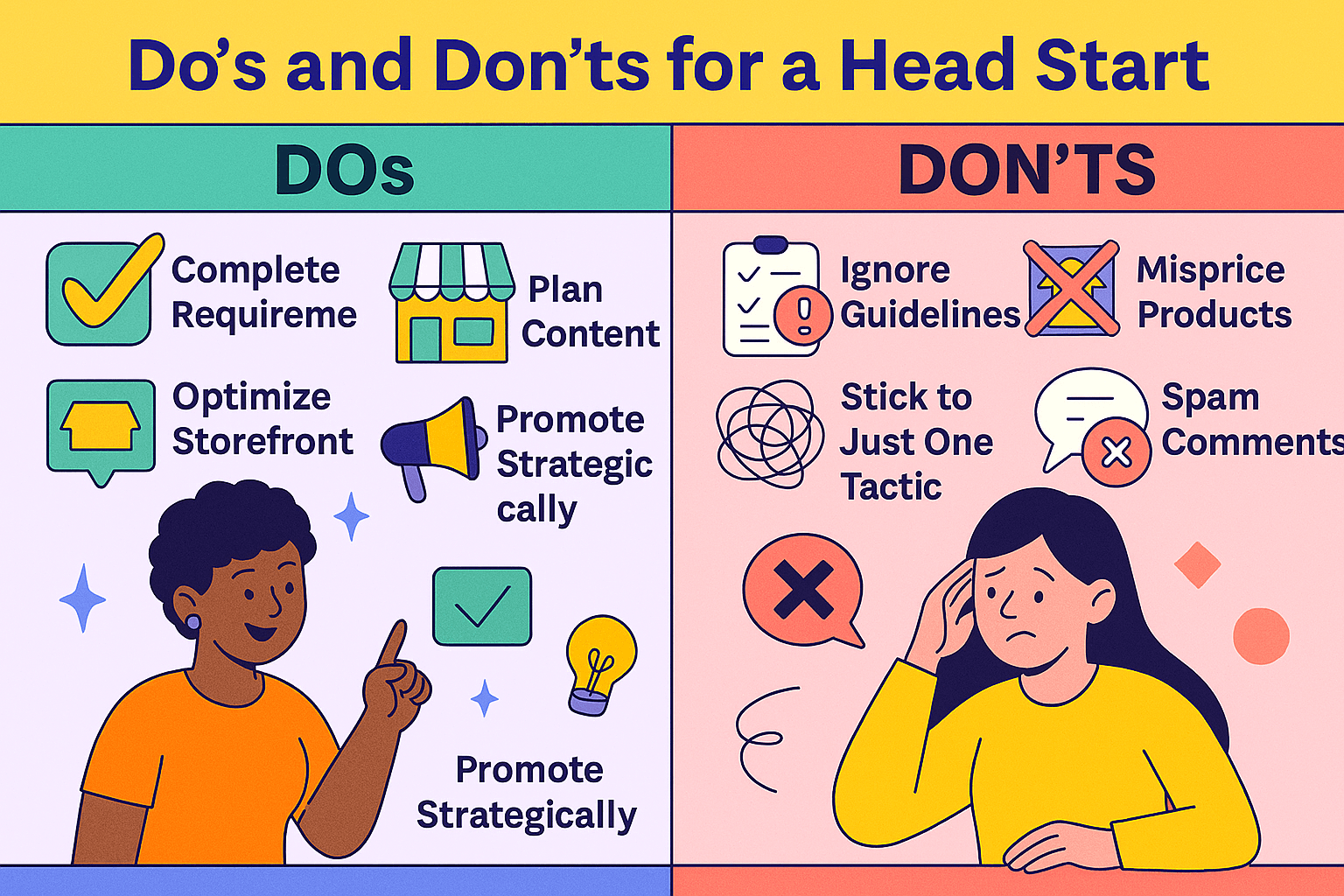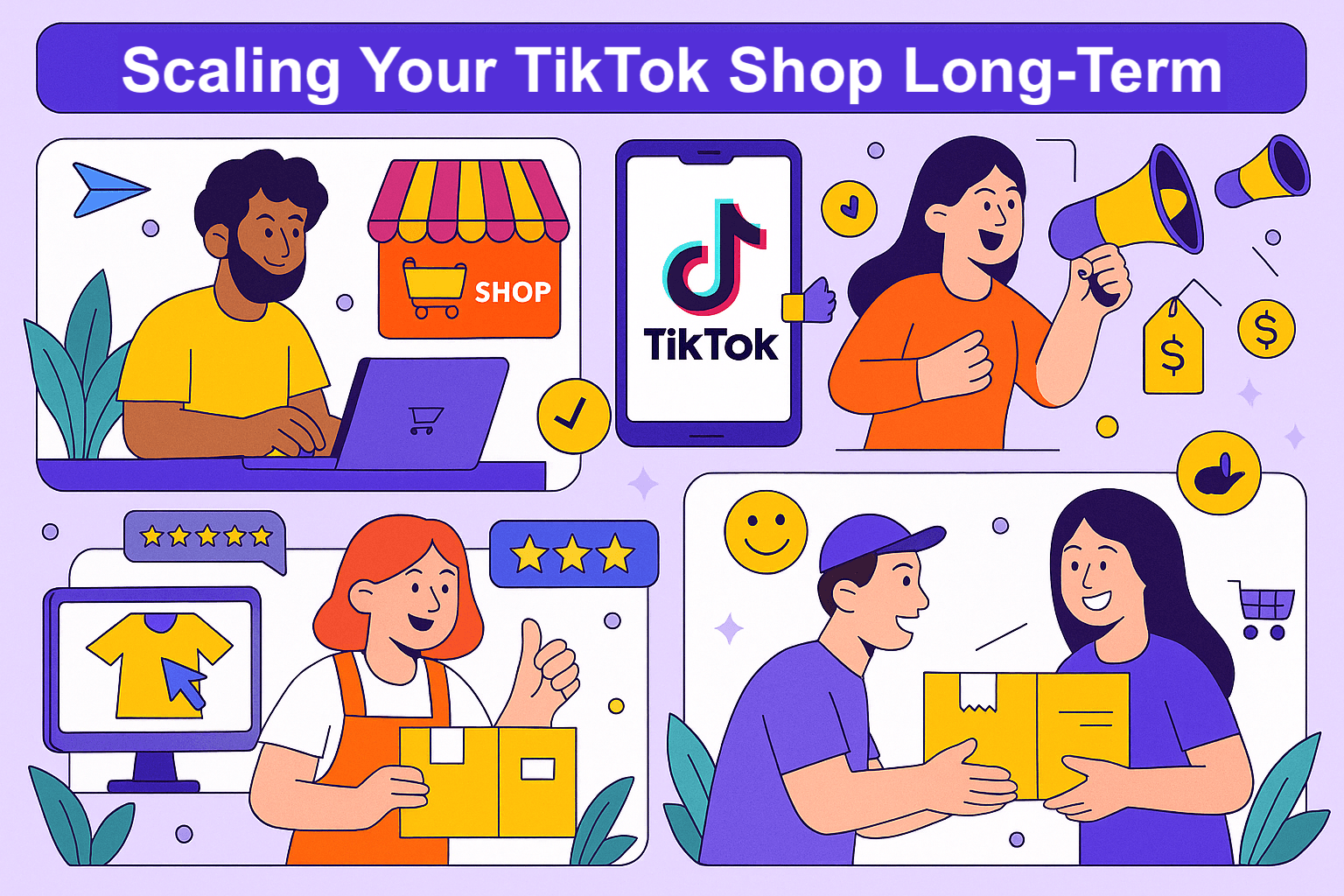Step 1
Create a TikTok Shop Seller Account
The very first step in setting up TikTok Shop is registering as a seller through the official TikTok Seller Center. This is where you’ll manage products, payments, logistics, and shop performance.
Choose the Right Account Type
TikTok gives you two account options during setup:
- Individual Seller Account – for solo creators or small sellers who want to sell personal or limited products.
- Business Seller Account – for companies with a registered business license, ideal for scaling operations or selling across multiple categories.
Tip: If you plan to sell more than a few products, apply for a Business account early. Switching later can delay payouts and force you to re-verify documents.
Eligibility Requirements
Not every region or account type is eligible to open a TikTok Shop. As of 2025, TikTok Shop is available in regions like the US, UK, Indonesia, Vietnam, Thailand, and parts of Europe. Sellers must also:
- Be at least 18 years old (19 in South Korea).
- Register with a valid phone number and email address.
- Provide a legal pickup address and return address during registration.
Important: You cannot use an “Organization Account” (a legacy TikTok account type) to sign up. TikTok will reject these automatically.
Do’s and Don’ts
- ✅ Do: Use the same legal name across your TikTok account, Seller Center registration, and bank details to avoid payout issues.
- ✅ Do: Double-check your region is supported before registering to prevent wasted time.
- ❌ Don’t: Register with mismatched emails, phone numbers, or incomplete shop information — these are common reasons for rejection.
- ❌ Don’t: Skip filling in warehouse or pickup address fields — they’re required for order fulfillment.
Getting the seller account setup right ensures you don’t run into delays later with product uploads, payouts, or verification. A clean application is your foundation for TikTok Shop success.
Step 2
Verify Identity & Documents
The most common reason TikTok Shop applications get rejected is incorrect or poor-quality documentation. This step requires attention to detail, because your approval depends on clean, consistent verification.
What Documents Are Required
The documents you need depend on your seller type:
- Individual Sellers: A valid government-issued photo ID (passport, national ID card, or driver’s license).
- Business Sellers: A business license, tax registration documents, and an authorized representative’s ID.
Note: In all cases, the name on your documents must match the name you provide in TikTok Seller Center and the name on your bank account.
Regional Eligibility
TikTok Shop is still rolling out globally. As of 2025, it’s available in countries like the US, UK, Indonesia, Vietnam, Thailand, Malaysia, and parts of Europe. If your region is not supported, your application will be rejected automatically — even if your documents are valid.
Do’s and Don’ts
- ✅ Do: Upload high-resolution scans or photos with all four corners visible. TikTok rejects cropped or blurry documents.
- ✅ Do: Use the same legal name across ID, Seller Center, and bank details. Mismatches cause payout delays or outright rejection.
- ✅ Do: Prepare a return address and pickup address during this stage, since TikTok requires them for logistics setup.
- ❌ Don’t: Submit expired IDs or licenses. TikTok will not accept them.
- ❌ Don’t: Attempt to “fix” mismatched names with abbreviations (e.g., “John D.” instead of “John David Smith”). Consistency is mandatory.
- ❌ Don’t: Skip tax documentation if you’re registering as a business. TikTok requires it for compliance in most regions.
Faster Approval
- Approval Time: Applications usually take 1–3 business days. However, sellers in high-priority markets (US, UK, Southeast Asia) often get reviewed faster.
- Photo Quality: TikTok’s system automatically rejects IDs with glare, shadows, or unclear edges. Take photos against a plain background with good lighting.
- Address Accuracy: Use a pickup/warehouse address in a supported region. Sellers who try to list overseas addresses often face rejections.
Completing this step correctly sets the tone for your entire TikTok Shop journey. A clean, approved verification unlocks the ability to upload products and connect your bank account without delays.
Step 3
Add Products to Your Catalog
Once your TikTok Shop account is verified, the next step is uploading products to your catalog. This stage directly impacts how often your items appear in search results, recommendations, and shoppable videos.
How to Upload Products
- Log in to the TikTok Seller Center.
- Navigate to Product Management and select Add Product.
- Fill in product details: title, category, price, stock, and shipping info.
- Upload high-quality images and, if possible, videos demonstrating the product.
- Submit for approval — TikTok typically reviews products within 24–48 hours.
Best Practices for Titles & Descriptions
- ✅ Use keyword-rich titles: e.g., “Oversized Hoodie – Unisex Streetwear 2025” instead of “Cool Hoodie.”
- ✅ Write descriptive product details that highlight benefits, not just features.
- ✅ Include size, color, and material variations to reduce returns.
- ❌ Don’t keyword stuff — TikTok’s search prioritizes natural phrasing.
- ❌ Don’t use vague or generic titles like “Nice Shirt” or “Best Gadget.”
Catalog Size Matters
TikTok recommends uploading your full product catalog, not just your bestsellers. Shops with larger catalogs get more exposure across the app. Even if a product isn’t your top seller, it can appear in TikTok’s algorithm-driven recommendations and attract niche buyers.
Do’s and Don’ts
- ✅ Do: Upload at least 5–10 products initially to boost shop credibility.
- ✅ Do: Use lifestyle images, not just plain product shots — TikTok favors content that feels native.
- ❌ Don’t: List restricted products (weapons, counterfeit items, adult products, etc.). TikTok bans these outright.
- ❌ Don’t: Copy-paste Amazon-style long titles. TikTok Shop prioritizes concise, mobile-friendly wording.
A Head Start
- Product Video Uploads: Shops that upload a short demo video with their product listing see higher click-through rates.
- Cross-Platform Sync: If you use Shopify or WooCommerce, integrate your catalog so stock updates automatically sync.
- Mobile-First Layout: Over 90% of TikTok shoppers browse on mobile. Test your product images on smaller screens to ensure text, colors, and packaging are clear.
Adding products isn’t just about filling a catalog — it’s about optimizing your listings so they rank well inside TikTok’s search, recommendations, and live shopping features.
Step 4
Bank Account & Payout Setup
After adding your products, you need to connect your bank account so TikTok Shop can process payouts. Without this step, your sales revenue will remain on hold until verification is complete.
How to Add a Bank Account
- Go to Seller Center and open the Finance or Payment Settings section.
- Select Add Bank Account and enter your details (account holder name, account number, bank name, branch, and SWIFT/BIC if required).
- Upload proof of account ownership (a bank statement or account screenshot with your name visible).
- Submit and wait for verification, which usually takes 1–3 business days.
Do’s and Don’ts
- ✅ Do: Make sure the bank account name exactly matches your Seller Center registration name. Even a small mismatch (e.g., missing middle name) can cause rejection.
- ✅ Do: Use a bank located in the same country as your TikTok Shop region (US shop = US bank account).
- ✅ Do: Keep a backup account ready — if your primary is rejected, delays can stretch weeks.
- ❌ Don’t: Use third-party or shared accounts. TikTok will only accept accounts legally tied to you or your business.
- ❌ Don’t: Skip this step, even if you don’t expect sales right away. TikTok will withhold payouts until verification is approved.
Smooth Payouts
- Payment Frequency: TikTok typically processes payouts weekly, but only after your account reaches a minimum balance (varies by region).
- Cross-Border Payments: If you plan to sell globally, consider setting up a multi-currency bank account to reduce exchange fees.
- Document Proof: Some sellers report faster approval when uploading both a bank statement and a voided check — even if only one was required.
Connecting your bank account early ensures smooth payouts once your first orders come in. It’s also a trust signal to TikTok that you are a legitimate seller prepared for real transactions.
Step 5
Shop Branding & Profile Setup
Your TikTok Shop profile is your storefront — it’s the first thing buyers see before making a purchase. A well-branded shop increases trust, boosts conversions, and makes your products stand out in TikTok’s algorithm-driven recommendations.
Key Elements of a TikTok Shop Profile
- Shop Name: Keep it short, memorable, and consistent with your brand identity.
- Logo: Use a professional, high-resolution logo that works well on mobile screens.
- Banner: Add a shop banner that reflects your niche (fashion, fitness, beauty, etc.).
- Category Tags: Select relevant categories to help TikTok’s algorithm surface your products to the right audience.
- Description: Write a concise description highlighting your brand values and product promise.
Do’s and Don’ts
- ✅ Do: Use consistent branding across TikTok, your shop, and your content — this signals professionalism.
- ✅ Do: Highlight unique selling points (e.g., “eco-friendly materials” or “fast 2-day shipping”).
- ❌ Don’t: Leave your shop profile blank or generic. Empty shops are flagged by buyers as unreliable.
- ❌ Don’t: Use stock images as your logo — authenticity builds trust.
Better Branding
- Mobile Optimization: Since over 90% of TikTok users browse on mobile, test how your logo and banner look on small screens.
- Ratings Display: TikTok prominently displays seller ratings and reviews — a polished profile encourages customers to leave positive feedback.
- Algorithm Boost: Shops with complete profiles are favored by TikTok’s algorithm, increasing visibility in For You Page product recommendations.
A polished TikTok Shop profile is more than aesthetics — it’s a growth lever. The stronger your branding, the more TikTok’s algorithm will trust your shop and the more confident buyers will feel when purchasing from you.
Step 6
Integrate Your TikTok Shop With Content
TikTok Shop doesn’t work in isolation — its success depends on how well you connect your products with engaging TikTok content. The algorithm rewards sellers who integrate shopping into videos, TikTok Lives, and creator collaborations.
Tagging Products in Videos
- ✅ Do: Tag products in as many videos as possible, not just your highest-performing content.
- ✅ Do: Use lifestyle-style videos (unboxing, tutorials, POVs) instead of purely promotional ads.
- ❌ Don’t: Spam product tags without context — TikTok may limit exposure if content feels inauthentic.
Using TikTok Live Shopping
Live Streams is one of TikTok Shop’s strongest growth engines. During live streams, you can display product links in real time, answer questions, and create urgency with limited-time deals.
- ✅ Do: Host regular Lives — consistency builds momentum and boosts algorithm signals.
- ✅ Do: Use giveaways, discounts, and countdown timers to increase conversions.
- ❌ Don’t: Go live without preparation — low-quality streams can hurt your credibility.
Affiliate Program Integration
The TikTok Affiliate Program allows creators to promote your products for a commission. Opening your shop to affiliates increases reach dramatically.
- ✅ Do: Start with a 10% commission to attract affiliates (TikTok recommends this baseline).
- ✅ Do: Collaborate with micro-influencers for authentic product promotions.
- ❌ Don’t: Rely only on one influencer. A broad mix spreads risk and boosts exposure.
Content Integration
- Boost Organic Videos: TikTok suggests running Spark Ads (Video Shopping Ads) on your best-performing organic posts for maximum ROI.
- Video Quantity: Brands that produce 5–7 variations per campaign see significantly higher sales compared to single creative pushes.
- TikTok SEO: Optimize your captions with keywords (e.g., “best skincare for 2025”) so your tagged products appear in TikTok search results.
Integrating your TikTok Shop with authentic, high-performing content is the real unlock for sales. Shops that only list products without tying them into videos, Lives, or affiliate programs rarely get traction.
Step 7
Analytics, Optimization & Growth
Once your shop is live and products are listed, success depends on how well you track performance and optimize for growth. TikTok Shop provides powerful analytics tools inside Seller Center that help you understand sales trends, customer behavior, and content effectiveness.
Key Metrics to Track
- Impressions: How often your products are shown across TikTok’s feed, search, and recommendation system.
- Click-Through Rate (CTR): Measures how many users click your product after seeing it.
- Conversion Rate: Percentage of clicks that turn into purchases — often influenced by product pages, reviews, and pricing.
- Ratings & Reviews: Customer feedback that strongly impacts visibility and trust.
Do’s and Don’ts
- ✅ Do: Review your analytics weekly to spot trends early.
- ✅ Do: Double down on products and video styles that already convert well.
- ✅ Do: Respond quickly to customer reviews to show engagement and improve credibility.
- ❌ Don’t: Ignore negative feedback — unresolved complaints hurt both rankings and reputation.
- ❌ Don’t: Focus only on ads — organic performance often provides more reliable insights into what customers like.
Faster Growth
- Algorithm Signals: Shops with higher response rates and better review scores often get priority placement in TikTok’s recommendations.
- Shipping Metrics: TikTok tracks on-time shipping closely. Late orders reduce your shop’s overall ranking.
- Content Iteration: Sellers who test 3–5 variations of video creatives per product see significantly higher conversion rates.
- Product Refresh: Update product titles and descriptions quarterly with trending keywords to stay relevant in TikTok search.
Analytics is not just about monitoring numbers — it’s about turning insights into action. Sellers who consistently optimize based on TikTok’s signals grow faster and avoid common plateaus.
Do’s and Don’ts for a Head Start
Starting a TikTok Shop can feel overwhelming, but following proven do’s and avoiding common mistakes gives you a powerful head start. These best practices come directly from TikTok guidelines and real seller experiences.
Do’s – What You Should Do
- ✅ Upload Your Full Product Catalog: TikTok favors shops with a larger variety of items, even if not all are bestsellers.
- ✅ Invest in High-Quality Visuals: Lifestyle images and short demo videos convert better than plain product shots.
- ✅ Leverage TikTok SEO: Use trending keywords in titles, descriptions, and captions so your products show up in TikTok’s search results.
- ✅ Join the Affiliate Program: Offering a 10% commission at launch helps you attract micro-influencers and expand reach quickly.
- ✅ Maintain Fast Shipping: TikTok tracks on-time delivery rates, and delays can lower your visibility.
- ✅ Engage With Reviews: Respond to both positive and negative reviews. Shops that reply actively get higher trust scores.
Don’ts – What to Avoid
- ❌ Don’t Rely Only on Ads: Sellers who run ads without building organic content often burn budget with poor ROI.
- ❌ Don’t List Restricted Products: Items like weapons, counterfeit goods, or adult products get flagged and may suspend your account.
- ❌ Don’t Leave Profiles Generic: A blank shop profile signals unreliability and discourages purchases.
- ❌ Don’t Ignore TikTok’s Native Style: Overly polished, corporate-style ads underperform. Use authentic, creator-style videos instead.
- ❌ Don’t Overlook Shipping Details: Missing warehouse or return addresses during setup can stall your approval.
- ❌ Don’t Skip Regular Analytics Checks: Successful sellers track performance weekly and adjust quickly to trends.
Insights
- Product Refresh: Update product titles and thumbnails every few months with trending TikTok keywords for better discovery.
- Diversify Influencer Partners: Don’t rely on one big influencer — micro-creators with niche audiences often outperform on ROI.
- Bundle Products: Sellers offering bundles (e.g., “3 skincare items for 1 price”) often rank higher due to improved conversion rates.
- Respond Speed: Shops that answer customer questions within 24 hours build stronger algorithm trust and visibility.
Following these do’s and don’ts ensures your TikTok Shop avoids the most common beginner mistakes and positions you for faster growth from day one.
Common Pitfalls New Sellers Face
Even after setting up a TikTok Shop correctly, many beginners run into avoidable problems that slow down growth or lead to account suspensions. Knowing these pitfalls in advance helps you save time, money, and effort.
- Registering From Unsupported Regions
TikTok Shop is not available in every country yet. Sellers trying to register from unsupported regions face instant rejections, even with valid documents. Always check the latest TikTok Seller Center list of eligible countries before applying. - Poor Verification Submissions
Low-quality document scans, mismatched names, or expired IDs are the number one reason for failed approvals. Sellers often lose weeks fixing rejections that could have been avoided with clean, consistent documents. - Ignoring Logistics & Shipping
TikTok tracks on-time delivery rates. Shops with frequent delays, poor packaging, or unreliable shipping partners lose visibility in recommendations. Customers also leave negative reviews, which further lowers your ranking. - Treating TikTok Shop Like Amazon
Many sellers upload plain product listings with generic titles (e.g., “Good Shirt”) and expect sales. TikTok Shop is content-driven commerce — products need to be integrated into videos, Lives, and affiliate promotions to gain traction. - Over-Reliance on Ads
Ads can boost reach, but new sellers often run campaigns without organic content to back them up. TikTok prioritizes authenticity, so ad-only strategies usually underperform. - Not Engaging With Reviews
Reviews strongly influence TikTok Shop visibility. Ignoring negative feedback damages trust, while actively responding builds credibility. Shops that reply to reviews consistently get higher algorithmic preference. - Failing to Optimize Product Listings
Many beginners upload products once and never revisit them. TikTok SEO requires refreshing titles, descriptions, and thumbnails with trending keywords to stay discoverable. Stagnant listings often drop in search ranking.
Insights on Avoiding Pitfalls
- Fulfillment Speed: TikTok penalizes late deliveries more harshly than most platforms — one seller’s rating dropped after just 10% late orders.
- Content Quantity: Shops producing 5–7 video variations per product grow 2–3x faster than those relying on a single video.
- Keyword Monitoring: Top sellers update product titles every quarter with new trending search terms (e.g., “TikTok viral gadget 2025”).
- Affiliate Mix: Sellers who rely only on one influencer risk stagnation. A network of micro-influencers drives steadier sales growth.
By avoiding these pitfalls, new TikTok Shop sellers can launch with fewer delays, gain algorithmic trust faster, and stay competitive in 2025’s crowded marketplace.
Scaling Your TikTok Shop Long-Term
Once your TikTok Shop is running smoothly, the next step is scaling beyond the basics. Growth comes from combining strong operations with advanced TikTok strategies that keep you ahead of the competition.
- Expand With Content-Driven Commerce
Don’t just upload products — keep building content around them. Launch mini-series, product tutorials, and seasonal campaigns to stay relevant in TikTok’s recommendation engine. - Double Down on TikTok Live
Live shopping is TikTok Shop’s most powerful conversion tool. As your audience grows, host weekly or even daily Lives to turn engagement into consistent revenue. - Build an Affiliate Network
Invite influencers, creators, and affiliates to promote your products. Sellers who build a broad network of micro-influencers often outperform those who rely only on big names. - Optimize Logistics for Speed
Invest in reliable fulfillment and fast shipping. TikTok’s algorithm rewards shops with higher on-time delivery scores — and buyers leave more positive reviews when orders arrive quickly. - Track & Refresh Regularly
Review analytics monthly to spot trends. Refresh product titles, thumbnails, and keywords every quarter to keep your listings aligned with TikTok’s search behavior.
Insights for Scaling
- Cross-Border Selling: As TikTok Shop expands globally, scale by offering products in new regions like Southeast Asia, the Middle East, and Europe.
- Multi-Channel Sync: Connect your TikTok Shop with Shopify or WooCommerce so you can centralize inventory and avoid stock issues.
- Data-Driven Ads: Use TikTok Ads Manager to retarget viewers who watched your videos but didn’t purchase — retargeting ads often deliver 3x higher ROI.
- Brand Collabs: Partner with complementary brands for TikTok campaigns that expand reach without doubling ad spend.
Scaling your TikTok Shop requires more than adding products — it’s about blending content, logistics, affiliates, and analytics into one growth engine. Sellers who continuously optimize and innovate will stay ahead in TikTok’s fast-moving marketplace.
To Set Up TikTok Shop the Right Way
TikTok Shop is one of the fastest-growing e-commerce platforms in 2025, giving creators and businesses the chance to turn content into conversions. But success starts with getting the setup right — from clean verification and optimized product listings to engaging content and consistent logistics.
By following this step-by-step guide and avoiding the common pitfalls, you’re not just opening a TikTok Shop — you’re building a foundation for long-term growth. Sellers who combine strong branding, quality content, and fast fulfillment gain algorithm trust faster and convert more buyers.
Ready to take your TikTok Shop to the next level? Start by boosting your visibility with TikTok Live Stream Views. The more people watching your live sales, the more conversions and credibility you’ll generate — giving your shop the head start it deserves.


















